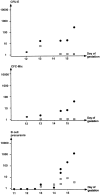Stem cell emergence and hemopoietic activity are incompatible in mouse intraembryonic sites
- PMID: 10429669
- PMCID: PMC2195563
- DOI: 10.1084/jem.190.1.43
Stem cell emergence and hemopoietic activity are incompatible in mouse intraembryonic sites
Abstract
In the mouse embryo, the generation of candidate progenitors for long-lasting hemopoiesis has been reported in the paraaortic splanchnopleura (P-Sp)/ aorta-gonad-mesonephros (AGM) region. Here, we address the following question: can the P-Sp/AGM environment support hemopoietic differentiation as well as generate stem cells, and, conversely, are other sites where hemopoietic differentiation occurs capable of generating stem cells? Although P-Sp/AGM generates de novo hemopoietic stem cells between 9.5 and 12.5 days post coitus (dpc), we show here that it does not support hemopoietic differentiation. Among mesoderm-derived sites, spleen and omentum were shown to be colonized by exogenous cells in the same fashion as the fetal liver. Cells colonizing the spleen were multipotent and pursued their evolution to committed progenitors in this organ. In contrast, the omentum, which was colonized by lymphoid-committed progenitors that did not expand, cannot be considered as a hemopoietic organ. From these data, stem cell generation appears incompatible with hemopoietic activity. At the peak of hemopoietic progenitor production in the P-Sp/AGM, between 10.5 and 11.5 dpc, multipotent cells were found at the exceptional frequency of 1 out of 12 total cells and 1 out of 4 AA4.1+ cells. Thus, progenitors within this region constitute a pool of undifferentiated hemopoietic cells readily accessible for characterization.
Figures









Similar articles
-
Emergence of T, B, and myeloid lineage-committed as well as multipotent hemopoietic progenitors in the aorta-gonad-mesonephros region of day 10 fetuses of the mouse.J Immunol. 1999 Nov 1;163(9):4788-95. J Immunol. 1999. PMID: 10528178
-
The splanchnopleura/AGM region is the prime site for the generation of multipotent hemopoietic precursors, in the mouse embryo.Vaccine. 2000 Feb 25;18(16):1621-3. doi: 10.1016/s0264-410x(99)00496-x. Vaccine. 2000. PMID: 10689138 Review.
-
Immature multipotent hemopoietic progenitors lacking long-term bone marrow-reconstituting activity in the aorta-gonad-mesonephros region of murine day 10 fetuses.J Immunol. 2001 Mar 1;166(5):3290-6. doi: 10.4049/jimmunol.166.5.3290. J Immunol. 2001. PMID: 11207284
-
Stimulation of mouse and human primitive hematopoiesis by murine embryonic aorta-gonad-mesonephros-derived stromal cell lines.Blood. 1998 Sep 15;92(6):2032-40. Blood. 1998. PMID: 9731061
-
[AGM region and hematopoiesis during ontogeny--review].Zhongguo Shi Yan Xue Ye Xue Za Zhi. 2005 Feb;13(1):164-8. Zhongguo Shi Yan Xue Ye Xue Za Zhi. 2005. PMID: 15748460 Review. Chinese.
Cited by
-
Bone morphogenetic protein 4 modulates c-Kit expression and differentiation potential in murine embryonic aorta-gonad-mesonephros haematopoiesis in vitro.Br J Haematol. 2007 Oct;139(2):321-30. doi: 10.1111/j.1365-2141.2007.06795.x. Br J Haematol. 2007. PMID: 17897310 Free PMC article.
-
Primordial hematopoietic stem cells generate microglia but not myelin-forming cells in a neural environment.J Neurosci. 2003 Nov 19;23(33):10724-31. doi: 10.1523/JNEUROSCI.23-33-10724.2003. J Neurosci. 2003. PMID: 14627658 Free PMC article.
-
Embryonic Origins of the Hematopoietic System: Hierarchies and Heterogeneity.Hemasphere. 2022 May 24;6(6):e737. doi: 10.1097/HS9.0000000000000737. eCollection 2022 Jun. Hemasphere. 2022. PMID: 35647488 Free PMC article. Review.
-
Activation of the vitamin D receptor transcription factor stimulates the growth of definitive erythroid progenitors.Blood Adv. 2018 Jun 12;2(11):1207-1219. doi: 10.1182/bloodadvances.2018017533. Blood Adv. 2018. PMID: 29844206 Free PMC article.
-
Mind bomb-1 is essential for intraembryonic hematopoiesis in the aortic endothelium and the subaortic patches.Mol Cell Biol. 2008 Aug;28(15):4794-804. doi: 10.1128/MCB.00436-08. Epub 2008 May 27. Mol Cell Biol. 2008. PMID: 18505817 Free PMC article.
References
-
- Houssaint E. Differentiation of the mouse hepatic primordium. II. Extrinsic origin of the haemopoietic cell line. Cell Differ. 1981;10:243–252. - PubMed
-
- Fontaine-Perrus J., Calman F.M., Kaplan C., Le Douarin N.M. Seeding of the 10-day mouse thymic rudiment by lymphocyte precursors in vitro. J. Immunol. 1981;126:2310–2316. - PubMed
-
- Cumano A., Dieterlen-Lièvre F., Godin I. Lymphoid potential, probed before circulation in mouse, is restricted to caudal intraembryonic splanchnopleura. Cell. 1996;86:907–916. - PubMed
Publication types
MeSH terms
LinkOut - more resources
Full Text Sources
Medical
Miscellaneous

